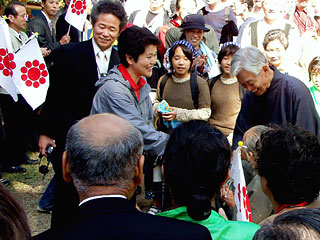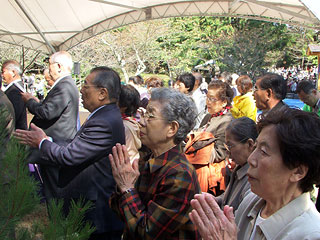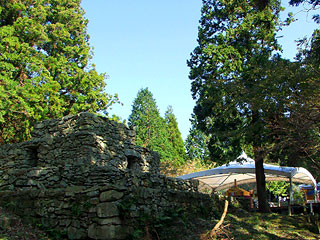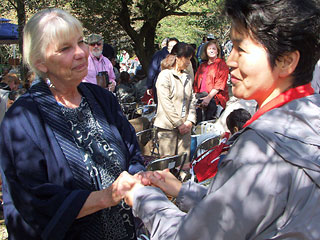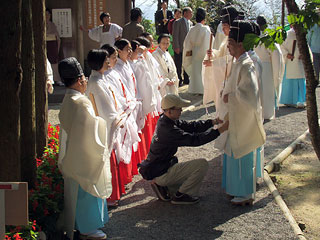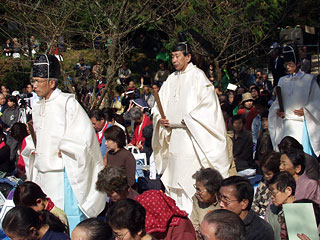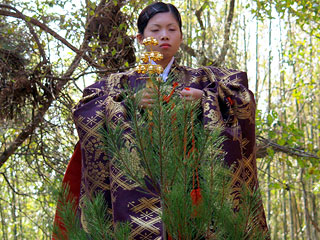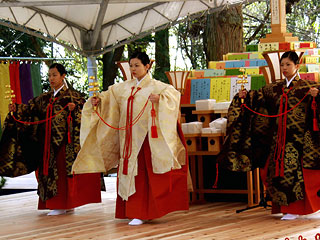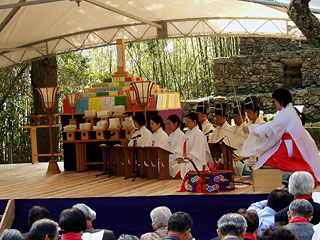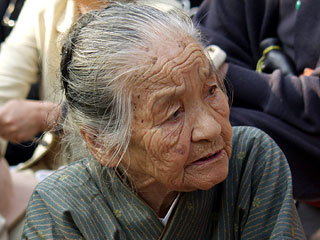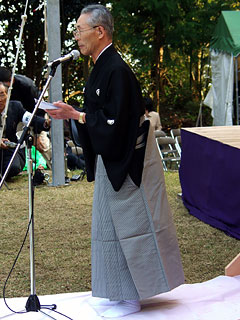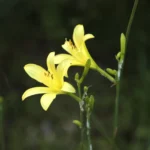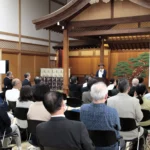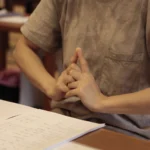Poetry on the Mountain Top
By Bill Roberts
It was a bright autumn day atop Kumayama, a 508-meter peak teeming with myth and mystery. Kurenai Deguchi, the Fifth Spiritual Leader of Oomoto, completed a two-and-a-half hour hike up the mountain that morning with about 200 Oomoto members then led a prayer service at an outdoor altar. She was now on her way to a private room to eat lunch and change into kimono for the Utamatsuri (poetry festival) that would begin soon.
Through the sun-splashed trees she recognized a visitor from abroad. Without hesitating, Mme. Deguchi changed course and strode across the green to greet Coeleen Kiebert, a teacher and artist from Santa Cruz, California, who has brought groups of her adult art students to Oomoto for the past six years. Arriving in Japan three days earlier, many in Kiebert’s group were still jet-lagged, but here they were on the mountain top for Oomoto’s first Utamatsuri on Kumayama in Okayama Prefecture.
The Spiritual Leader and Kiebert first met in 2002. On Kumayama, they grasped hands in a warm greeting as if they were life-long friends. As I watched their chance encounter I thought: This poetry festival is proving to be a series of chance meetings for me, too.
In the course of a few hours, I encountered many Oomoto followers whom I first met on a three-day trip to Okayama in December 2001. [=> The Mochi Mash ] Hisashi Tanimoto, head of the Okayama branch who spent a day showing me around the prefecture three years ago, was busy hosting the Utamatsuri, but took a few minutes to say hello to me.
I exchanged greetings with Iwao Kaneshige and his family. Kaneshige is a professional potter who welcomed me into his workshop in Bizen not far from Kumayama. I also ran into Sawae Okamoto, who served an unforgettable dinner made of wild ingredients she gathered from the hills around her farmhouse restaurant in remote Bisei. [=> A love letter from Oomoto: The Merry Mothers of Yamabe ]
And last but not least, I saw Shima Miyake, now 94 years old and still bursting with life. She greeted me most warmly three years ago at the Okayama branch’s tsukinamisai (monthly service), where she participated enthusiastically.
Utamatsuri like an old friend
Even the Utamatsuri, one of Oomoto’s most colorful pageants, felt like an old friend. It was my second festival. I attended the one held in November 2002 to celebrate the 50th anniversary of the founding of Oomoto’s Tokushima branch on the island of Shikoku. [=> Utamatsuri ]
Although the format of the two Utamatsuri was the same, the atmosphere at each was different. Both festivals took place outdoors in beautiful settings but there the similarities ended. The Shikoku Utamatsuri was held on the grounds of the Tokushima branch, surrounded by pines on a balmy night with a three-quarter moon, the air scented by the nearby sea.
In contrast, the Kumayama Utamatsuri, on Oct. 24, 2004, was held on a sunny, breezy afternoon less than a week after Japan’s 23rd typhoon of the year. The mountain was scarred by downed trees and typhoon damage. The bright sun slashed through the trees in the fresh air for most of the afternoon, abating only at the end of the Utamatsuri.
One thing that was not different between the two festivals is the myth behind the Utamatsuri, although Kumayama adds its own twist to the ancient legend.
The Storm God, Susanoo no Mikoto, slew a dragon to rescue Kushinadahime and her parents. Afterwards, he took Kushinadahime as his bride and brought peace to the land as its ruler. In celebration of these events he composed a poem, believed to be Japan’s first. Susanoo was better in battle than at ruling, which wore him down. To help her husband relax, Kushinadahime played music by plucking on a bowstring with an arrowhead. She also fastened the bowstring to the bottom of a wooden tub and beat it with a stick.
That’s the gist of the myth. In it are the beginnings of Japanese poetry and of two ancient musical instruments still in use: the two-string yakumokoto and the bow drum.
Oomoto incorporates various aspects of the myth in its Utamatsuri. The chief priest recites the poem attributed to Susanoo as a prayer to open the festival. Then three young women, representing Kushinadahime and her parents, enter the stage carrying clusters of bells and perform a purification dance. Next a choir begins to chant the selected poems. The event is accompanied by yakumokoto and bow drum.
A special altar holds a colored card, one for each poem chanted. About 50 were chosen from among hundreds submitted by Oomoto followers for Kumayama. The ancient poetic form is the 5-line, 31-syllable tanka. Onisaburo Deguchi, the Co-Founder of Oomoto, was a prolific poet, writing thousands of tanka, some of them exquisite and others not. Today, Oomoto followers write tanka and submit to a monthly poetry journal.
Kumayama’s mysterious ruin
Kumayama (which means “bear mountain”) adds an interesting aspect to the Susanoo myth. The top is the site of a ruin, a pyramid of sorts. Twelve meters square at the base, constructed of rocks fitted without mortar, the ruin is estimated to have been built in the 8th century AD. Despite much research, no one knows who built it or why.
Onisaburo Deguchi thought he knew why. He declared the ruin is the tomb of Susanoo no Mikoto or a part of him. Portions of Susanoo might be buried elsewhere, Onisaburo said. No one can prove Onisaburo wrong, of course.
During a visit to the ruin two years ago, the Spiritual Leader, who is Onisaburo’s great granddaughter, casually told her host—Tanimoto—that it might be nice to hold an Utamatsuri on Kumayama some day because of Onisaburo’s belief that Susanoo is buried there.
The Okayama branch took her comment to heart and mounted an enormous and costly effort to hold the Utamatsuri. Logistics included managing transportation on the winding one-lane road to bring 1,000 people to the top. Unlike Mme. Deguchi, most of the people attending did not hike to the spot; they were carried by bus within a few hundred meters of the site. This exercise had to be carefully coordinated so no buses were going up and down the mountain at the same time. When the Utamatsuri ended, it took almost three hours to transport everyone off the mountain.
The Okayama branch also had to lug all the necessary equipment to the top—including a portable stage, tents, loudspeakers, and food and drink for the multitude. In all, it was a huge undertaking. For that reason, no one expects a repeat of the Kumayama Utamatsuri anytime soon, making the festival all the more special.
Onisaburo Deguchi revived the traditional poetry festival in 1935. The ancient Japanese would gather to recite or chant poems as a form of entertainment. Oomoto holds an Utamatsuri each August as part of its Summer Festival in Kameoka to celebrate the anniversary of Onisaburo’s birth. Perpetuating the Utamatsuri is another example of how Oomoto blends traditional arts with spiritual practice. In ancient times, the festivals were usually held at a shrine, beside a river or on a mountain top—just like the Kumayama Utamatsuri.
